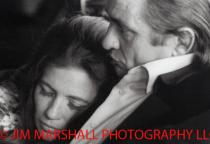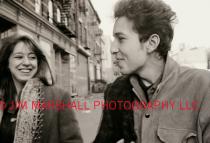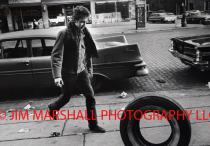Behind every great man there has to be a great woman or so the cliché goes, and I think at times Jim was a big believer in this idea of selfless support, but more often than not I think he saw through the stereotype to realize the true power and creative spark that catalyzed some amazing women, their men, friendships and the relationships that he was lucky enough to witness.
In honor of Women’s History Month, the next few blog posts will focus on Jim’s relationship to women artists – both in front of and behind the camera -- and his unique ability to capture the lovely intensity and joy shared among compelling musical icons, their mates and muses. Personally, I think it’s one of the greatest parts of Jim’s legacy.
Some of the best examples of Jim’s uncanny ability can be found in his photos of the relationship between Johnny Cash and June Carter Cash so beautifully documented in “Pocket Cash,” the last book Jim approved in early 2010 before he passed away in March of last year.
If you are in San Francisco, New York or London this month and care to see what I’m talking about, you must check out the “Pocket Cash Photo Exhibits” – featuring many never-before-printed images -- launched in support of this project.
To spur my memory, I just finished thumbing again through my copy of “Pocket Cash,” and there are so many amazing images that capture the profound strength and intense love and support among Johnny and his closest family, friends, musical collaborators and muses -- often one and the same folks. But, to me, it was clearly the bond between June and Johnny that held the most fascination for Jim, and I think he says it best in his afterword to “Pocket Cash":
“… (Johnny) didn’t suffer fools gladly. He kept a close bunch of friends that were very tight to him. The people who loved him, loved him fiercely, and vice versa. His wife, June Carter, was his lifeline. I remember when they got back together, about a year before the Folsom concerts. He stopped doing drugs. June kept him off the drugs and saved his life. I think the day she died, he died.”
Interestingly, Jim said he first met Johnny Cash when he was hanging out with Bob Dylan in some Greenwich Village nightclub in 1962.
Bob Dylan was, perhaps, the best example of this question of trust, love and control among equals. Jim always said to me that there were two Dylans, the one before his motorcycle crash in 1968 in Woodstock and the one after. Jim didn’t care much for the post-crash Dylan so it’s no surprise one of the most beloved of Jim’s Dylan shots was taken informally in 1963, just Dylan and his first great love, muse and creative mentor – Suze Rotolo. Dylan, Suze, Jim, folk singer Dave Van Ronk, his wife Teri and another unidentified gal were just strolling to breakfast one morning in NYC’s West Village, Jim doing his best fly-on-the-wall Henri Cartier-Bresson impersonation.
Suze Rotolo became an instant ’60s icon as “the girl on Dylan’s arm” on the cover of his huge 1963 breakthrough studio album, “The Freewheelin’ Bob Dylan” – though she was much, much more than just an appendage. Active in CORE and the civil rights movements, she helped the boy from Minnesota see “how the other half lived,” inspiring Dylan to write about the brutal 1955 murder of Emmett Till and, when he was pining for her while she was away for two months in Italy, “Don’t Think Twice, It’s All Right,” “Boots of Spanish Leather” and “Tomorrow Is a Long Time.” Suze Rotolo passed away of lung cancer at the age of 67 on Feb. 24. A great loss. R.I.P. Suze.
To me, one of the main things about Jim that was so damn touching is how touched and honored he was to witness love and trust in all its forms. Keep in mind that I met him when he’d already lived the better part of five decades, yet he was still such a big kid in some ways especially when it came to family and friends. I always felt it was because he was an only child -- and often estranged from much of his family -- that compelled him to be able to see the best and brightest in people, at least some of the time, when he chose to. Or, as Jim would say to me time and again: “When they let me.”
- Jim Marshall Photography LLC Newsroom blog
- Log in to post comments


